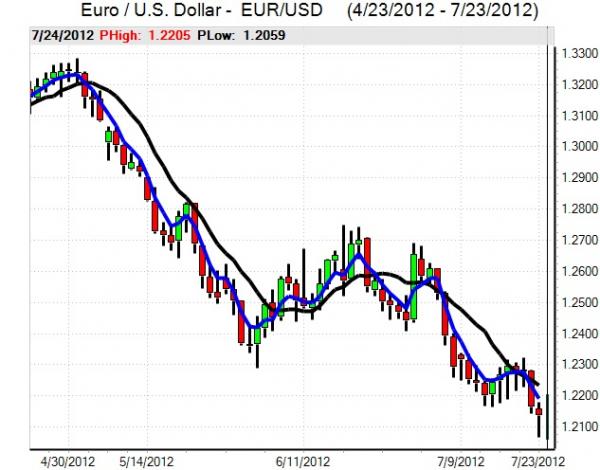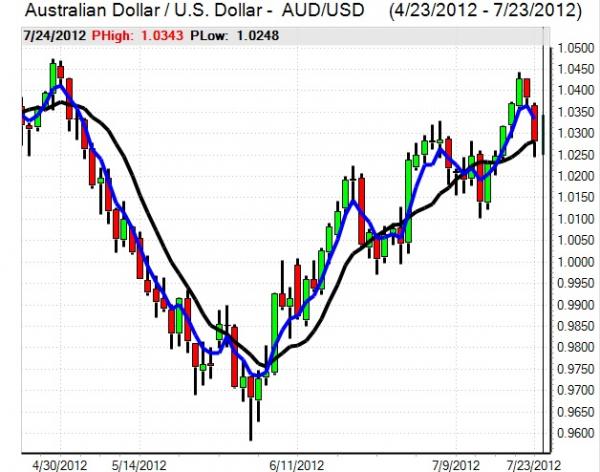EUR/USD
The Euro remained under intense pressure during the Europeans session on Monday and dipped to fresh two-year lows below 1.2075 against the dollar. Spain remained an extremely important market focus during the day with fear dominating markets. Following Valencia’s move to request funds on Friday, there were reports that Murcia would follow suit and there were expectations that further states would also seek government aid.
There were major concerns surrounding the economic outlook with recession putting upward pressure on the budget deficit. Spanish benchmark bond yields increased to fresh 2012 highs above the 7.50% level which reinforced fears that Spain was heading rapidly for a sovereign bailout as domestic policy protests also increased.
As far as the economic data is concerned, there was a decline in consumer confidence to a fresh 35-month low of -22 for the latest month. The PMI data will be watched extremely closely on Tuesday and a further deterioration would reinforce fears over a deepening recession within the Euro area. There were also increased fears surrounding the Italian regions on reports that they would also seek central-funding support.
There was a slightly more optimistic stance surrounding Greece from the IMF who stated that it would start discussions with Greece as part of the troika talks. There were, however, still major fears surrounding the Greek outlook amid fears that it was set to default, especially with reports that German Chancellor Merkel had ruled out additional support. Troika discussions will be watched very closely over the next few days
The Euro did find some relief on short covering once European trading had closed and equity markets rallied from lows with the Euro moving back to the 1.2135 area late in the US session. Moody’s put the credit ratings of German y and Netherlands on negative watch which reinforced fears that Germany would also be engulfed by the Euro-zone crisis and prevented the Euro securing a stronger rebound, especially with increased speculation that the Euro would be used as a global funding currency.

Source: VantagePoint Intermarket Analysis Software
Call now and you will be provided with FREE recent forecasts
that are up to 86% accurate* 800-732-5407
If you would rather have the recent forecasts sent to you, please go here
Yen
The dollar dipped to 7-week lows below the 78 level against the yen on Monday as risk appetite deteriorated further and there was renewed defensive demand for the Japanese currency. The Euro also dipped to 12-year lows below the 94.50 level.
There was renewed speculation over intervention which also discouraged aggressive yen buying close to the 78 area and the dollar moved back towards 78.40 as the yen also retreated on the crosses. There was some easing of defensive yen demand following the Chinese PMI data, but the yen was still broadly resilient during the session. Further concerns surrounding the global economy and Euro-zone structural vulnerabilities continued to underpin the Japanese currency.
Sterling
Sterling was subjected to further selling pressure against the dollar on Monday and dipped to lows below 1.55 in European trading. The UK currency pushed to fresh 44-months highs around 0.7775 against the Euro before being subjected to profit taking and a retreat back to the 0.7820 area.
There were further expectations of support from diversification flows into Sterling, especially with Euro-zone fears reaching a fresh intensity. These flows were not enough to prevent Sterling reaching a 7-week low against the Japanese currency.
There were also important concerns surrounding the UK economic outlook with Wednesday’s GDP data a particular focus given expectations of a further quarterly decline which would reinforce recessionary conditions. Political pressures will also increase further if there is another decline in output.
Swiss franc
The dollar continued to push higher against the franc on Monday with a peak at a fresh 19-month high in the 0.9950 area before a partial retreat as the wider Euro moves continued to dominate the Swiss currency through the impact of the 1.20 minimum Euro level.
Underlying deflation fears will be lessened slightly by a weaker Swiss currency and this could eventually ease pressure for the 1.20 minimum level to be sustained. For now, the bank is likely to remain strongly committed to defending the Euro, especially with the high degree of uncertainty over the underlying Euro outlook which will discourage radical policy choices.

Source: VantagePoint Intermarket Analysis Software
Call now and you will be provided with FREE recent forecasts
that are up to 86% accurate* 800-732-5407
If you would rather have the recent forecasts sent to you, please go here
Australian dollar
The Australian dollar remained under pressure on Monday and retreated to lows around 1.0250 as risk aversion intensified with declines in equity markets. There was some stabilisation in conditions later in the US session.
There was some further relief during Asian trading on Tuesday with the HSBC Chinese PMI index rising to a six-month high of 49.5. Although still below the pivotal 50 level, it eased immediate fears surrounding the risks of an even more severe downturn and the Australian dollar consolidated around the 1.03 level.



